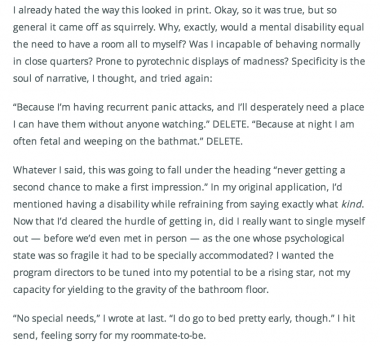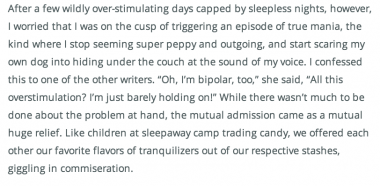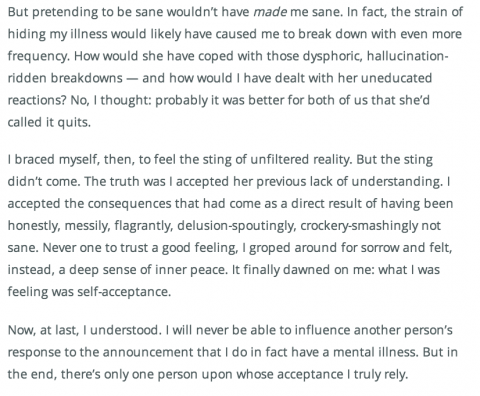November 28, 2014 - 07:15

Katie Hinchey
November 28, 2014
Disability Studies
Unpacking All Of Our Closets
Introduction
In this paper, I will be doing a close reading of several personal narratives that explore the intersectionality of mental illness and queer identity. As a self-identified lesbian who also suffers from depression and anxiety I have experienced many of the feelings portrayed in these narratives. I will use the texts “Compulsory Able-Bodiedness and Queer/Disabled Existence” by Robert McCruer and Ellen Samuel’s “My Body, My Closet: Invisible Disability and the Limits of Coming Out” to analyze and challenge the experiences of these writers.
Personal Narratives
I analyzed at four personal narratives of mental illness. All were from Autostraddle.com but each explored different diagnoses from queer people of varying age, race, socioeconomic status, and many other identity categories. These narratives had strong common themes; the problems experienced because of social stigmas, invisibility within the queer community, and the consequences of coming out as a disabled queer.
The first piece, “Dust to Dark: The Colors of my Craziness” is an entirely personal narrative by ‘RaucousNight’. RaucousNight has Borderline Personality Disorder and writes a prose piece of her journey to self acceptance. “These lies, white and black, that I’ve told to myself and others for self-protection, need exposure. Then the truth will be known, and the truth will set me free.” (RaucousNight 2013)
In “Big Reveal” author Jenna Leigh Evans explores the consequences of coming out personally and professionally with an anxiety disorder. After coming out publicly as a lesbian at thirteen, Evan’s felt secure in her queer identity. She also first attempted suicide during this time in her life but did not yet feel the shame and invisibility of her mental illness. Evan’s then describes how different mental illness as an adult is experienced publically and privately. Evan’s experience with loss and ostracization because of her disability is a story of pain and struggle.
Evans does not use statistics in her writing like those found in Helen McDonald’s “To Be Queer, Black, and ‘Sick’” but their experiences are very similar. To Be Queer, Black, and “Sick” is a shorter narrative that weaves statistics and historical facts with her personal experiences with mental health. McDonald admits to leaving her partner because of the “unreasonable standards” she had been socialized to hold mentally ill people to. This narrative also speaks to how differently people of color experience mental illness. Evans opens her narrative with the haunting line, “The first woman I ever loved told me that when you’re queer and Black, illness is a shadow that always follows you but that no one ever acknowledges.” This speaks to the pressure and stigma that is pervasive in Black American culture. Evans weaves statistical information and autobiographical details to tell the story of how she came to resist the cultural narrative imposed on her.
Emily Brooks, an autistic queer woman interviewed other queer women on the Autism spectrum to write, “Body as a Second Language: Navigating Queer Girl Culture on the Autism Spectrum”. This piece is more structured and less autobiographical. Brooks focuses on dating and the struggles autistic queers face in the larger LGBTQ community. Autistic queers are not only invisible but actively battle social norms that keep autistic queers from social interaction. Brooks writes, “On the spectrum, speaking “neurotypical”, or non-autistic, body language is like traveling to a new culture without learning which of your normal hand symbols and facial expressions are hideously insulting there.” (Brooks) Brooks also writes about the coping mechanisms that many of those she interviewed use.
The Queer-Crip Analogy
In "MY BODY, MY CLOSET: Invisible Disability and the Limits of Coming-Out Discourse” Ellen Samuels states, “it behooves us to refocus our endeavors from the visible signs of these identities to their invisible manifestations. The focus on specularity and visible difference that permeates much disability theory creates a dilemma not only for nonvisibly disabled people who wish to enter the conversation but for the overarching concepts of disability and normalization themselves.” (Samuels 310) Samuels writing is not only an argument of the strength of the queer/crip analogy but a deep exploration of the politics of invisibility. Rather than accepting simple analogies that tend to make all experiences seem equivalent (epitomized in sex-race analogies, for instance when white feminists have analogized their own oppression to the oppression of black civil rights activists), Samuels believes investigating analogies can provide a more complicated understanding about of marginal identities. (309) To demonstrate this Samuels uses autobiographical narratives of her femme lesbian and nonvisibly disabled identity, much like the collection of narratives I have gathered, to analyze how invisible identities change the way queers and crips see the world. (Samuels 308)
In “Compulsory Able-Bodiedness and Queer/Disabled Existence” Robert McRuer writes of how queer and crip existence are interwoven. One similarity he argues for is that ideal heterosexuality and ideal able-bodiedness are both fought for by the majority of people but they are actually impossible to achieve. “Able-bodied identity and heterosexual identity are linked in their mutual impossibility and in their mutual incomprehensibility…each is an identity that is simultaneously the ground on which all identities supposedly rest and an impressive achievement that is always deferred and thus never really guaranteed” (93). Therefore, McRuer concludes that both heterosexual identity and able-bodied identity should be analogized because both of them have impossibility of completeness. McRuer argues that if you are a heterosexual, your disability queers you and if you are able bodied, than being queer disables you. The two can not be separated.
There are many other reasons queerness and disability can be connected. Historically queer and disabled people were highly medicalized identities, many times unnecessarily. McDonald reminds us that, “For example, most prominently in the 1960s, white doctors institutionalized Black men involved in civil rights protests (particularly in Detroit) on the grounds that the behaviors these men defended as political activism was really schizophrenic rage and volatility” (McDonald 2014). Queers and crips may experience deep connections to others who shared their identity instead sharing their subordinated identity with their family like religious or racial minorities. Queers and crips also share a sameness of resistance, not only experience. (Samuels 237) Both analogies have same goal of persuading the listener of the validity and urgency of the speaker’s original experience, in all of the personal narratives the writers spoke of their struggles with acceptance and the pervasive theme of not being taken seriously.
Invisibility
All four narratives touch on the experience of being closeted by both disability and sexuality. McDonald writes, “In mainstream mental health settings, [LGBT folks] often feel compelled to hide their sexual orientation or gender identity; conversely, in the LGBT community, mention of their mental health status is often unwelcome.” The experience of facing discrimination in the workplace, social situations, and in personal relationships is all too real. Jenna Evans piece “The Big Reveal” focuses on her experience at a writers retreat and how she wrestled with whether or not to tell the people around her about her disability or to suffer the consequences of overstimulation in silence.

(Evan, "The Big Reveal")
Invisibility also means constantly defending of how disability affects you on a daily basis. Many of the authors spoke to defending themselves to friends, family, and partners. One autistic woman interviewed by Brooks recounted being left because of her neuroatypical status, ““She thought I was faking it to get attention. Either that, or, ‘You’re disabled, and I don’t want to date someone who’s disabled.” (Brooks 2014) This questioning does not only come from those unaffected by disability. Helen McDonald, who identifies as disabled, writes about how even she has treated others with mental health problems dismissively.
“I didn’t understand that not everyone is fortunate enough to “get better,” especially as easily as I did. I held other people to unreasonable standards...We may even roll our eyes when one of our queer siblings “forgets” to leave their depression, anxiety, PTSD, OCD, bipolarity, or other illness at home. I too have rolled my eyes before, reducing another person’s struggle to “extreme sensitivity” or “unnecessary drama”. (McDonald 2014)
Coming Out
The pressure to come out can be suffocating because of the consequences of the invisibility discussed above. Evans writes, “Revealing that you’re mentally ill has consequences that you can neither predict nor control. The only control you’ve got is the way you choose to play the revelation out...Much depends on your emotional investment: it’s scarier to risk a bad reaction from someone you really like... It’s hard to frame the bald fact of mental illness for potential landlords, employers, roommates, or co-workers without fearing the worst. ” (Evans 2014) Brooks echoes, “Do we tell her we’re autistic, risking possible prejudice, or keep it a secret, even if she misreads our stilted body language as rude, awkward stupidity instead?” This choice and it’s consequences are a daily roller-coaster. Samuels writes that even after years of experience as disabled and queer, we still make choices about coming out or passing on a daily basis in “personal, professional, and political contexts” (Samuels 311).
Coming Out can be both an experience of further loss and isolation but it can also operate as a process of redefinition and self-acceptance (Samuels 310). Samuels argues that coming out for disabled is a process of redefinition of one’s personal identity through rejecting of tyranny of “normate”, positive recognition of their impairment, and embracing disability as a valid social identity. Brooks speaks to the intersectionality of queer and crip identities directly when exploring how coming out as crip in the LGBTQ community can be received. “Who understands choosing pride over shame more than us, the members of the queer community?” Narratives of coming out play an important role in visibility politics and work to decrease stigmas in every area of life. Samuels writes that visibility is the basis of community and a means of enacting social change. At that lonely writers retreat Evans writes of what happened when she chooses to reveal the problems she is experiencing because of her mental illness to another participant:

(Evans, "The Big Reveal")
All four of the writers experienced intense pain in their romantic relationships due to misunderstanding and invisibility. Coming out is never easy but did sometimes alleviate the negative experiences. The women interviewed by Brooks have a myriad of coping mechanisms to operate in the ‘queer girl world’ including coming out and smashing pre-conceived notions of social norms. “Far from being passive victims, they learned to cope with everyday sources of social skill bewilderment, communication breakdown, and sensory overload to enjoy themselves in the community.” (Brooks 2014) Using tools like online dating, autistic queer women have a more comfortable avenue to explore romantic relationships. While it may not always be successful, “I had a woman break up with me because she didn’t think I was the same person in real life as I was online,” shared Fern, who “came across as much more self-confident online.” It is still a great place to come out without immediately intensely painful results.
These stories of invisibility and silence are much more complicated and intense than I have explored here. Through a close reading of these narratives I have gained a deeper understanding of why it is so important to speak our struggles out loud but why so few of us do. As a femme lesbian suffering from an anxiety disorder and depression, I deeply connected with Ellen Samuels argument and excavation of the connection between these two identities. All of the authors have experienced shame, loss, and confusion like Samuels and I. Her insistence on self acceptance is the resolution to most of these narratives. We can not depend on the queer community to hold us up even if our identities mirror each other so closely. We must first accept ourselves and then we can move forward in the world raising our voices together to make sure our stories are no longer hidden.

(Evans, "The Big Reveal")
Works Cited
Brooks, Emily. "Body as a Second Language: Navigating Queer Girl Culture on the Autism Spectrum." Autostraddle. Autostraddle, 02 Jan. 2014. Web. 20 Nov. 2014.
Evans, Jenna L. "The Big Reveal." Autostraddle. Autostraddle, 30 Sept. 2014. Web. 20 Nov. 2014.
McDonald, Helen. "To Be Queer, Black, and "Sick"" Autostraddle.Com. Autostraddle, 19 Feb. 2014. Web. 20 Nov. 2014.
McRuer, Robert. "Compulsory Able-Bodiedness and Queer/Disabled Existence." The Disability Studies Reader. 3rd ed. New York: Routledge, 2010. 383-92. Print.
RaucousNight. "Dust to Dark: The Colors of My Craziness." Autostraddle. Autostraddle, 18 Feb. 2013. Web. 20 Nov. 2014.
Samuels, Ellen J. "MY BODY, MY CLOSET: Invisible Disability and the Limits of Coming-Out Discourse." GLQ: A Journal of Lesbian and Gay Studies 9.1-2 (2003): 233-55. Project MUSE. Web. 20 Nov. 2014.
